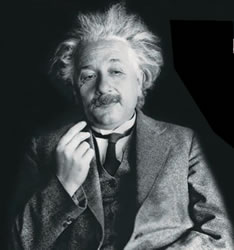
Dimdima
Online Children's Magazine from India

Dimdima
Online Children's Magazine from India

There is a galaxy of great minds associated with the study of Light. They include luminaries from Greece and other parts of Europe, Arabia, Egypt and India. Standing head and shoulders above the rest is Albert Einstein who was awarded the Nobel Prize in Physics in 1921 for his explanation of the Photoelectric Effect.
Albert Einstein was born on 14 March, 1879 in Ulm, Germany. His father made a living as a featherbed salesman. Albert was slow to develop speech and did not utter his first word until the age of three.
A Poor Student
The rote learning at school bored him. He got low grades and would often get into trouble with his teachers, who were strict disciplinarians. Once, his seventh grade teacher got so frustrated with him that she told him that he ‘would never get anywhere in life’.
Einstein hated school. He tried to get out of his last year of high school by taking an entrance examination to join the famous Swiss Polytechnic University in Zurich. He failed. After a year at a boarding school, he finally succeeded in gaining admission at the university. Einstein graduated in 1900 and frantically searched for a job as a teacher. No one would hire him. He took up a job as a clerk at the Swiss Patent Office but failed to make an impression. His request for a promotion from a patent clerk third class to second class was rejected.
Most of his work in the office was related to the transmission of electric signals and electrical-mechanical synchronization of time. The brilliant scientist in him, however, was all the while busy performing experiments mentally behind the clerical desk.
Nobel Class Work by a Third Class Clerk
Many metals have the property of emitting electrons when light shines on them. Electrons emitted in this manner are called photoelectrons. When light is shone onto a piece of metal, a small current flows through the metal. The light gives its energy to the electrons in the atoms of the metal and allows them to move, producing the current. Not all colours of light affect metals in this way. For instance, red light cannot produce a current in a metal no matter how bright it is, but dim blue light is able to.
Einstein stated that light was made up of many small packets of energy called photons that behaved like particles. He showed that red light cannot dislodge electrons because its photons did not have sufficient energy. However, blue light is able to eject electrons — each blue photon has more energy than a red photon.
Einstein Chases Speed of Light
Einstein found out that the speed of light in a vacuum is constant and is an absolute physical boundary for motion, which means that nothing can travel faster than light.
1905 is hailed in the history of science as Einstein’s annus mirabilis — year of wonders. He produced four papers that changed the course of science. The first one was on light being made up of discrete packets of energy called photons (a paper on photoelectric effect). The second paper (not related to light) solved the problem of random movement of particles suspended in a fluid, using the molecular theory of matter. The third paper was on the famous Special Theory of Relativity, on the independence of velocity of light from the speed of the observer (light is one speed in the universe that is constant — that is, it’s always the same no matter how fast you’re moving when you measure it).
The fourth paper contained his famous equation E=mc2. Science had always treated matter and energy as two separate entities. Einstein showed that matter can be converted to energy and vice-versa at velocities comparable to that of light. This equation gave the formula for such a conversion, with ‘E’ as the energy, ‘m’ as the mass of the matter that is being converted to energy and ‘c’ as the speed of light. Light has an incredible speed of 300 million metres per second in a vacuum.
Einstein published more than 300 scientific papers and 150 non-scientific papers in his lifetime. The General Theory of Relativity, which Einstein developed in 1916 and Quantum Mechanics to which he contributed immensely, are the two pillars of modern physics. In 1917, Einstein published an article which led to a process that makes lasers possible. The laser is one form of light that has many applications in modern medicine and industry.
Einstein,whom many regard as the greatest genius that ever lived on this planet, passed away on 18 April, 1955 at Princeton,in New Jersey, USA.
— Dr. A.P. Jayaraman
EXPLORE MORE...
Get Help or Give Help.
- Do you have a Science Question?
- Post it here and get the answer.
- Some questions posted by others are not yet answered.
- View those questions and answer them.
Dimdima is the Sanskrit word for ‘drumbeat’. In olden days, victory in battle was heralded by the beat of drums or any important news to be conveyed to the people used to be accompanied with drumbeats.
Bharatiya Vidya Bhavan
K. M Munshi Marg,
Chowpatty, Mumbai - 400 007
email : editor@dimdima.com
Bharatiya Vidya Bhavan
505, Sane Guruji Marg,
Tardeo, Mumbai - 400 034
email : promo@dimdima.com
Dimdima.com, the Children's Website of Bharatiya Vidya Bhavan launched in 2000 and came out with a Printed version of Dimdima Magazine in 2004. At present the Printed Version have more than 35,000 subscribers from India and Abroad.